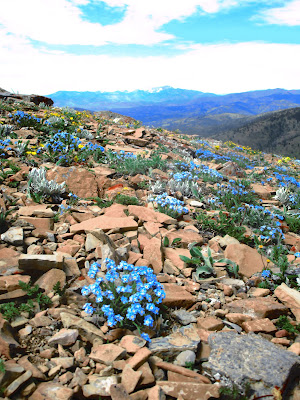 |
| Many dead trees litter this section of the CDT |
 |
| A grizzly's calling card. We saw seven piles along the way |
 |
| The late alpine flower bloom --- Forget-Me-Nots |
 |
| We were blown away by a vast Forget-Me-Not bloom |
 |
| The scenic marker of our CDT section |
Many of the section hikes along the Continental Divide Trail are worth repeating.
Such was the case Wednesday when we hiked from Flesher Pass to Rogers Pass, a jaunt of 13.5 miles with elevation gain in excess of 3,000 feet.
I've also skied this section twice.
It is a particularly nice hike in the late Spring and early Summer as the alpine flowers emerge.
I'm used to visiting the Rogers Pass area to see the flowers in late May and early June. There they peak the first week of June.
So I was blown away by the display of blue Forget-Me-Nots and Jacob's Ladder blooms about half-way into our hike on a very steep hillside where there is a transition from forest to open slope. This section is sort of scary as a misstep would send a hiker down precipitously. I can't imagine how we did this on skis.
Tons of trees have died and collapsed on the trail between Flesher and this point. We scrambled around a half-dozen in the trail.
While Forget-Me-Nots dominated this section, every quarter mile or so, a different alpine flower, like the Jacob's Ladder or Silky Phacelia would dominate.
Also in the trail at seven different points was sizeable grizzly scat. There is a bear(s) frequenting this section of the CDT. They had been digging for roots here, too.
We were disappointed that we didn't see any bitterroot, which we know is blooming now elsewhere, nor had the beargrass begun, although we saw some nubbins near the Rogers Pass trailhead.
To the west, Red Mountain, at 9,411 feet, the highest point in the Bob Marshall-Scapegoat wilderness complex provided a scenic backdrop. I noted that most of the snow had already been stripped away, so it is climbable.
I had expected to see other CDT hikers, but there were none. We encountered a horseback party near Anaconda Hills from Wolf Creek's Blacktail Ranch of four who said they were doing a loop ride.
The skies were hazy and clouded up later in the day and the temperature heated up, but not as high as the 90 degrees in Great Falls.
We could see a small fire smoking near Lincoln to the south, but otherwise we were rewarded with great views of mountain ranges and buttes in all directions.



















